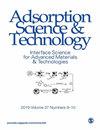Biomass-Derived Adsorbents for Dye and Heavy Metal Removal from Wastewater
IF 3.2
4区 工程技术
Q2 CHEMISTRY, APPLIED
引用次数: 19
Abstract
Wastewater has a high concentration of dyes and heavy metals, which are the two most significant contaminants. Due to their high toxicity and vulnerability, they possess a potential threat to human health as well as the ecosystem. There are many ways to eliminate these pollutants from water but adsorption has attained much interest because of its low cost, easy application, and no secondary pollutants. Biomass is considered an ecological burden and a reason for the reduction in the earth’s carrying capacity. These materials may be used as cost-effective adsorbents to remove dyes and heavy metals from wastewater. This paper highlights recent advances made in dye and heavy metal adsorption in the last 10 years. The prime focus of this review paper is on the direct application of these biomasses without any chemical or physical alteration. The removal efficiencies and adsorption capabilities of different biomass-derived adsorbents for the removal of dyes and heavy metals from wastewater are summarised in this study. Additionally, the adsorption mechanisms underlying the removal of dyes and heavy metals using biomass-derived adsorbents have been discussed, with a focus on two kinetic models: pseudofirst-order and pseudosecond-order. Furthermore, the Langmuir and Freundlich isotherms were utilised to verify the experimental findings and to quantify the amount and degree of adsorption favorability. Based on what has been covered in the literature, the conclusion has been drawn. The future research needs are proposed in the area of biomass-derived adsorbent development, their modification for improved efficiencies, and application on large-scale wastewater treatment plants.生物质吸附剂去除废水中的染料和重金属
废水中含有高浓度的染料和重金属,这是两种最重要的污染物。由于其高毒性和脆弱性,它们对人类健康和生态系统具有潜在威胁。去除水中这些污染物的方法有很多,但吸附法因其成本低、应用方便、无二次污染物而备受关注。生物质被认为是一种生态负担,也是地球承载能力下降的原因。这些材料可以用作具有成本效益的吸附剂,以从废水中去除染料和重金属。本文重点介绍了近10年来染料和重金属吸附方面的最新进展。这篇综述论文的主要焦点是在没有任何化学或物理变化的情况下直接应用这些生物质。本研究总结了不同生物质衍生吸附剂对废水中染料和重金属的去除效率和吸附能力。此外,还讨论了使用生物质衍生吸附剂去除染料和重金属的吸附机理,重点讨论了两个动力学模型:假一级和假二级。此外,Langmuir和Freundlich等温线用于验证实验结果,并量化吸附的有利程度和量。根据文献中所涵盖的内容,得出了结论。提出了生物质衍生吸附剂的开发、改性以提高效率以及在大型污水处理厂中的应用等方面的未来研究需求。
本文章由计算机程序翻译,如有差异,请以英文原文为准。
求助全文
约1分钟内获得全文
求助全文
来源期刊

Adsorption Science & Technology
工程技术-工程:化工
CiteScore
5.00
自引率
10.30%
发文量
181
审稿时长
4.5 months
期刊介绍:
Adsorption Science & Technology is a peer-reviewed, open access journal devoted to studies of adsorption and desorption phenomena, which publishes original research papers and critical review articles, with occasional special issues relating to particular topics and symposia.
 求助内容:
求助内容: 应助结果提醒方式:
应助结果提醒方式:


